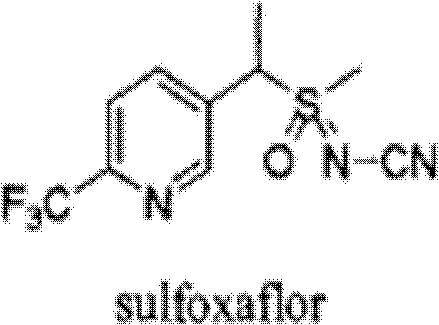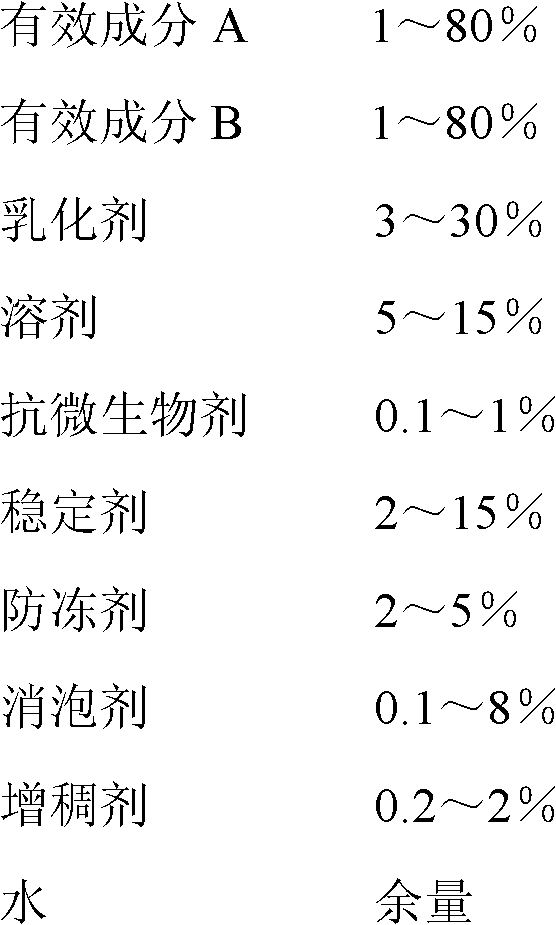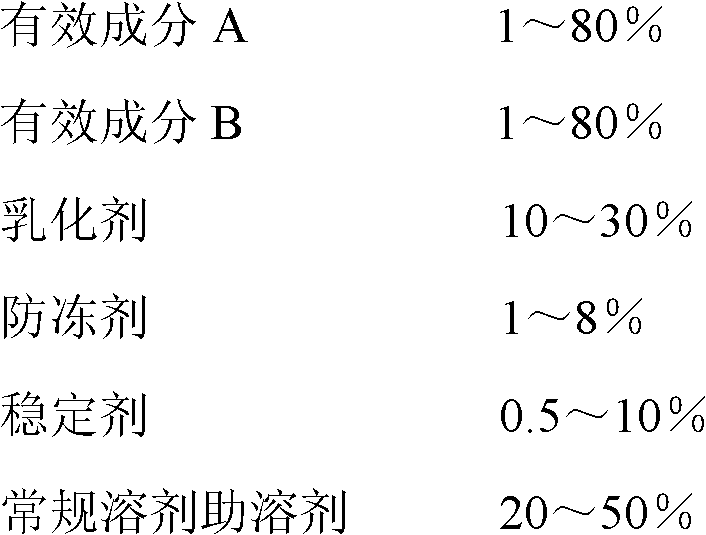Insecticidal composition containing sufoxaflor and neonicotine compounds
An insecticidal composition and the technology of the composition, which can be applied in the directions of insecticides, biocides, animal repellents, etc., can solve the problems of serious drug resistance and decreased control effect, and achieve excellent control effect, reduce dosage, and reduce environment. The effect of pollution
- Summary
- Abstract
- Description
- Claims
- Application Information
AI Technical Summary
Problems solved by technology
Method used
Image
Examples
Embodiment approach
[0015] In the following technical solutions, component A is selected from sulfenalazine, and component B is selected from neonicotinoid insecticides imidacloprid, acetamiprid, nitenpyram, thiamethoxam, thiacloprid, clothianidin , any one of dinotefuran.
[0016] One of the technical solutions of the present invention, the insecticidal composition is an aqueous emulsion, and the weight percent of the component is:
[0017]
[0018] The specific production steps of the water emulsion are as follows: first, add the original drug A and B, the solvent, the emulsifier and the cosolvent together to dissolve into a uniform oil phase; add part of the water, antifreeze, antimicrobial agent and other other The pesticide adjuvants are mixed together to form a uniform water phase; while stirring at high speed in the reactor, add the oil phase to the water phase, slowly add water until reaching the phase inversion point, turn on the shearing machine for high-speed shearing, and add the r...
example 1
[0048] (1) Test drug
[0049] 96% sulfenalazine TC, 95% imidacloprid TC, all the above TCs are provided by Qingdao Hailier Pharmaceutical Group R&D Center.
[0050] First dissolve the original drug with acetone, according to the results of the preliminary experiment, the appropriate amount of the two original drugs is formulated into 5 different ratios, and then each treatment is diluted with acetone into 5 series of concentration gradients for use. The ratios of the five active ingredients in different proportions of sulfenalazine and imidacloprid are respectively 8:27; 10:25; 12:23; 14:21;
[0051] (2) Test target
[0052] Wheat aphids were collected from the field population of the wheat experimental field of Qingdao Agricultural University. During the experiment, wingless adult aphids of the same size were selected for testing.
[0053] (3) Test method
[0054] Determined by the spot method recommended by NY / T1154.1-2006. Clean the micro dropper with solvent and adjust...
example 2
[0072] (1) Experimental drug to be tested
[0073] 96% sulfenalazine original drug, 99% acetamiprid original drug, the above-mentioned original drugs are all provided by Qingdao Hailier Pharmaceutical Group.
[0074] (2) Test target
[0075] Citrus aphids were collected from the Jiangxi citrus orchard population, and the wingless adult aphids with the same size were selected for the experiment.
[0076] The experimental method is the same as the activity measurement example 1
[0077] (3) Toxicity test results and analysis:
[0078] Table 2 The results of indoor determination of sulfenalazine and acetamiprid on citrus aphids
[0079]
[0080]
[0081] As can be seen from Table 2, in the mixing of different proportions, the co-toxicity coefficients are all greater than 120, showing a certain synergistic effect, in which sulfenalazine: acetamiprid is a synergistic effect of 8:12 Most obviously, the co-toxicity coefficient was 148.97. The test results showed that both ...
PUM
 Login to View More
Login to View More Abstract
Description
Claims
Application Information
 Login to View More
Login to View More - R&D
- Intellectual Property
- Life Sciences
- Materials
- Tech Scout
- Unparalleled Data Quality
- Higher Quality Content
- 60% Fewer Hallucinations
Browse by: Latest US Patents, China's latest patents, Technical Efficacy Thesaurus, Application Domain, Technology Topic, Popular Technical Reports.
© 2025 PatSnap. All rights reserved.Legal|Privacy policy|Modern Slavery Act Transparency Statement|Sitemap|About US| Contact US: help@patsnap.com



